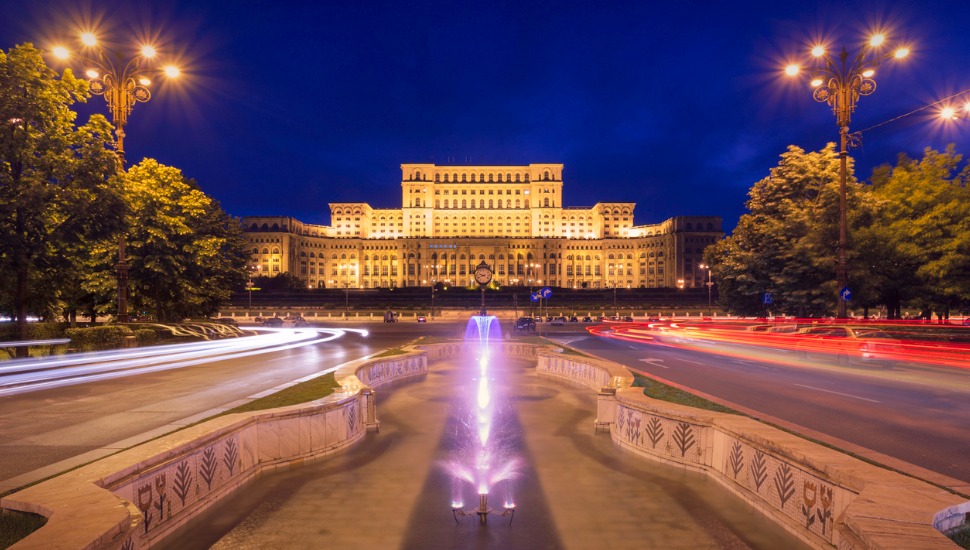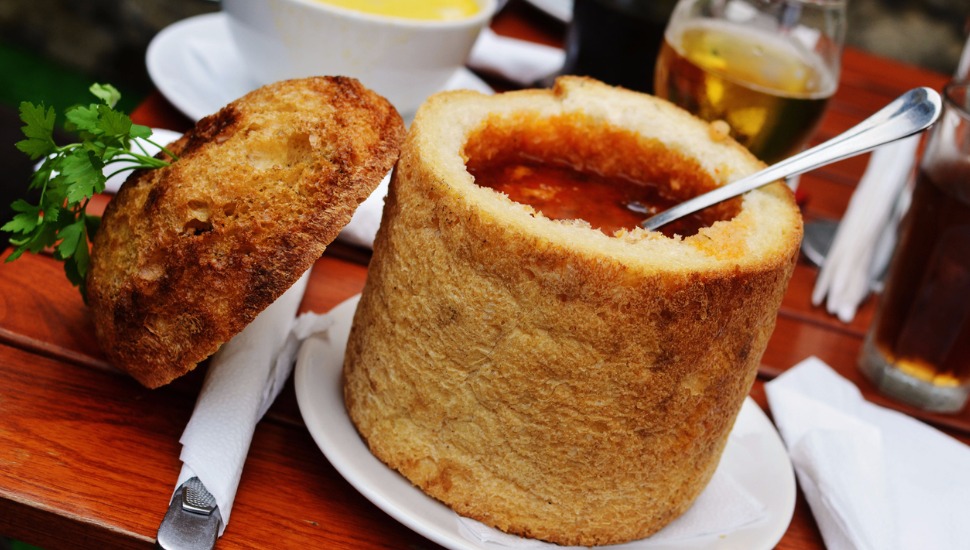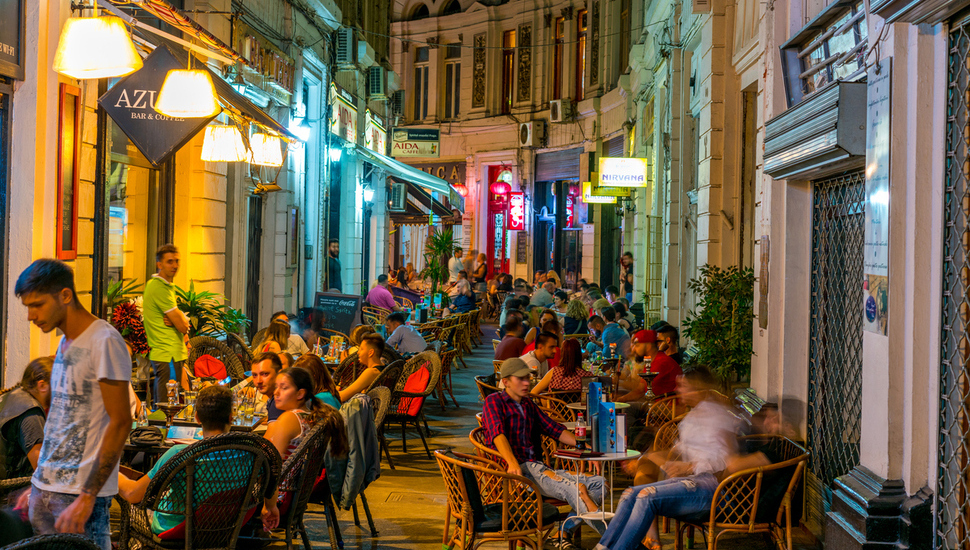Bucharest - Romania’s Resurgent Capital - Our Guide
Romania's sprawling capital city doesn't always get the respect it deserves - and as such tends to be bypassed by travellers more interested in the vampire tales of Transylvania. But given enough time, Bucharest reveals itself to be a vibrant, cosmopolitan city with absorbing museums, pleasant parks and an edgy, fun vibe.
Rising from the ashes
After the destruction of World War Two, Communist rule under Nicolae Ceaușescu saw the city's architecture take a brutalist turn. However, a number of grand old survivors remain amongst the tower blocks: neo-classical mansions and art deco delights can be found lurking in various corners of the city.
Arriving at Henri Coandă Airport
If you land at Bucharest Henri Coandă International Airport, hop on the 780 Express line which connects to the Gara de Nord (the main railway station).
Alternatively, you can travel directly into the city centre by taking the 783 Express, which also runs at night (every 40 minutes).
Note that the word 'express' here is used loosely, as the buses make multiple stops.
Airport stops are in front of the Arrivals Terminal and Departures Terminal. The price for one trip is 3,5 lei; A more convenient magnetic card is available and valid for two trips, costing 7 lei.
A brief history
The city grew to prominence in the 19th century, when its cosmopolitan high culture garnered it the nickname 'Little Paris'. Much of the splendid architecture built in this period was laid waste after Two World Wars, with rebuilding taking place under communism - resulting in a brutalist approach to new buildings. However, a number of notable belle epoch and art deco beauties remain. Nicolae Ceauşescu was the head of state since 1967, whose repressive, totalitarian regime remained in power until 1989, when the anti-communist Romanian Revolution occurred.
When to go
The Romanian climate is comparable to that of the UK, but with colder winters and sometimes hotter summers. While the weather can be unpredictable, visiting between March and October should mean you avoid the coldest and wettest months.
Currency
The Romanian 'lei' or 'leu' is used here, at a current exchange rate of around 5 to 1 GBP. Despite the weakness of the pound, Romania remains relatively cheap for Britons.
Getting around
The car is most certainly the star in Romania - but the road network is definitely not. Congestion is commonplace around the capital, so avoiding rush hour is prudent if possible. Despite the traffic, in this car-first city you may be best off taking taxis and rideshares; Taxify and Uber both operate here. Expect to pay about 1.39 lei per km (around 25p).
Buses and trams
Cheap and abundant, buses and trolley buses/trams run in all parts of the city, starting at around 4.30am. However, they can be crowded and locals tend to linger by the doorways, making getting on and off an additional challenge. Pickpockets find easy pickings in these confined areas, so take care of wallets and purses.
Metro
The first section of the Bucharest Metro opened in 1979 so the system is far from old. The stations are somewhat tired looking, but the trains are newer and get you from A to B much faster than ground level alternatives. The system is cheap and runs from 5am.
Things to do
Palace of the Parliament

Arguably the most famous - or infamous - building in Bucharest, the Palace of the Parliament is a lumbering dreadnought of dictatorial ego. The national seat of power is the second largest administrative building on the planet, after the Pentagon. Built under Ceaușescu's regime and completed in 1984, a visit to the building can be booked in advance.
Bucharest Park Life
Parks are central to life in Bucharest, where locals come to socialise and relax. The largest is the 187 hectare Herăstrău Park (Sector 1) which surrounds a large lake (boats can be hired). Other pleasant green spaces include the Botanical Gardens and Cismigiu Gardens. The concrete Carol Park, home to the Monument to the Heroes of the Struggle for Freedom and Socialism, is also worth spending an hour or two in.
Arcul de Triumf
Inspired by its bigger brother in Paris, this arch was built to honour the dead of World War One.
Cycle tour
A cycle tour is a great way to explore this large city (the 6th biggest in the EU), especially if you're tired of cramming yourself into trams and buses. A popular half day 'slow tour' is available, which begins at 11am and lasts for four hours, taking in the city's many green spaces and the Charles de Gaulle Square, Revolution Square and the Palace of the Parliament.
Bucharest Food Tour

A number of food tours are available, presenting the perfect way to sample a broad range of Romanian cuisine. Skip meals before the tour begins so you have plenty of space for the forthcoming treats: sausage, bacon, goat's cheese, bean soup, sweet cheese pie, sweet pepper, plum jam and Romanian-style bread are among the highlights. Expect to be offered a glass or two of wine by the tour's end. Guides pick you up at your accommodation and the three-hours of feasting begins.
Old Town, Bucharest / Centru Vechi
This buzzing zone of bars, restaurants and kebab shops is laid out around the city's old heart, home to remnants of the 15th and 16th centuries. Around old buildings like the 15th century Old Princely Court, the city's key nightlife hub has emerged, making Bucharest far more liveable than in times past. Just a few years before, the area was considered a slum - and is still shabby in parts.
Museum of the Romanian Peasant
This popular and absorbing museum is built around a collection of peasant costumes, knick-knacks, and partially restored houses. Around the back is a charming 18th century church, while in the basement is a striking exhibition detailing the Ceauşescu-era program of land collectivisation, which all but wiped out peasant life.
Where to stay
If you're on a budget, Bucharest offers some of the best designed and welcoming hostels in Europe. Podestel Bucharest has a social family-friendly atmosphere with workshops, a garden and a café/bar, while its sister hostel Podstel Umbrella offers a more relaxed environment with private rooms. A bed in a dorm can be as little as £7, while a private room costs around £27.
A room in a hotel costs between £25 and £75, with many plush four-stars available at the upper end of this bracket - making Bucharest the perfect place for a little 'flashpacking'.
Dangers and annoyances
Bucharest is a very safe city, but there are a few downsides to be aware of.
Driving standards are lower than in the UK, a situation made worse by heavy congestion. The pedestrian does not come first in Bucharest, a fact underlined by the parlous state of the pavements.
Taxi meters are rigged to over-charge, so either establish a price before you get in, or use an app like Taxify or Uber and book in advance.
Pickpockets do operate in the city, especially on the transport system. And as with any big city, mugging does take place on occasion.
Change money at banks, or use an ATM. Changing money on the street or in private exchange offices may well result in you being cheated.
Stay away from stray dogs, packs of which roam the streets at night. They can be aggressive.
Hidden gems
Pasajul Vilacrosse and Pasajul Macca
 iStock/Holgs
iStock/Holgs
These are two small passages in the city centre lined with chic cafes and restaurants. You'll soon understand why Bucharest is sometimes called 'Little Paris'.
Pura Vida Sky Bar
For fantastic views over the city and equally fantastic cocktails, ascend the five flights of stairs to reach this trendy roof top bar.
Carturesti Carusel
If you love books, be sure to visit this stunning white-washed store in the Old Town. A tranquil place to relax with your holiday read.
Get a Quote